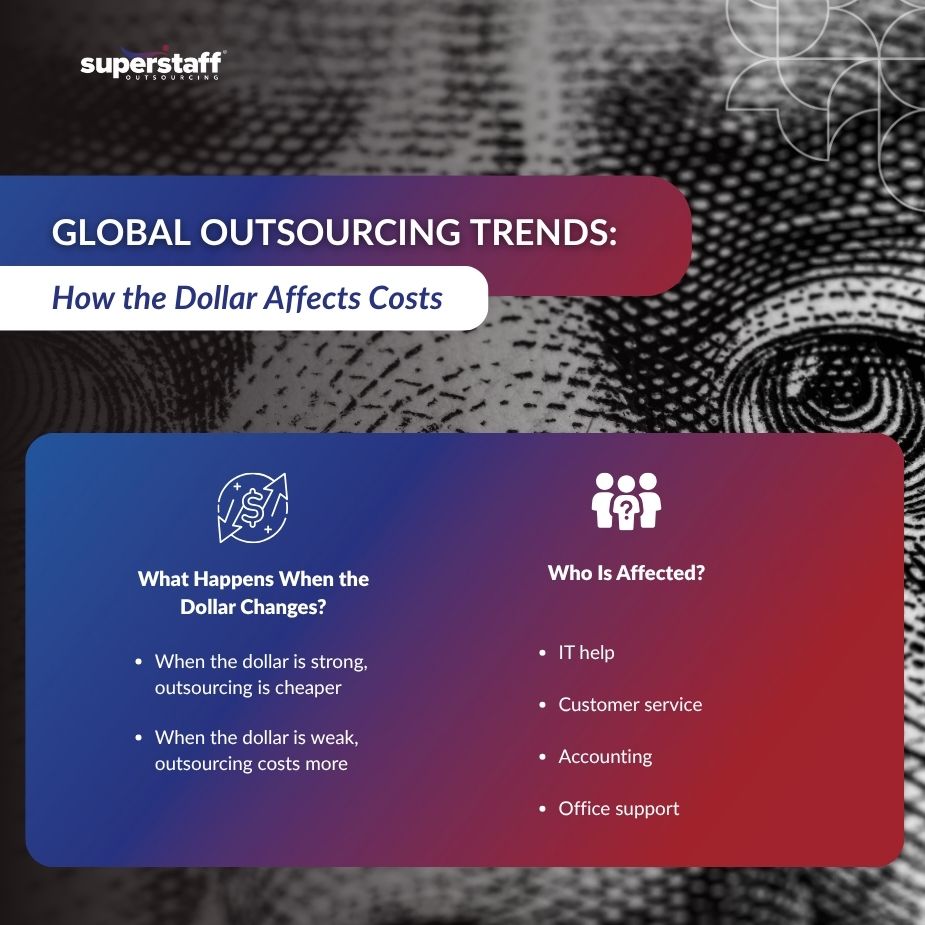
The U.S. dollar has recently weakened against several major foreign currencies. While this shift raises concerns for some industries, it also creates a strategic advantage for businesses willing to explore global outsourcing trends. One of the most practical responses to this trend is to consider outsourcing key operations to global partners.
Lower exchange rates make offshore services even more cost-effective. Companies can now stretch their budgets further by partnering with providers in countries where the dollar holds more value. This approach supports smarter spending, better resource allocation, and long-term financial stability.
With the right offshore investment strategies, businesses can align with current global outsourcing trends to reduce expenses, improve efficiency, and support global market expansion. Now is the optimal time to consider offshore partnerships that deliver both savings and flexibility.
Understanding the Dollar’s Role in Outsourcing

Currency fluctuations directly influence the cost-effectiveness of international outsourcing. When the U.S. dollar strengthens, services priced in foreign currencies become more affordable for U.S. companies, reducing outsourcing expenses. Conversely, a weaker dollar makes these services more expensive, potentially increasing costs.
This dynamic affects various sectors, including customer support, IT, accounting, and back-office operations. Businesses often monitor exchange rates to optimize their outsourcing strategies and budgets.
Global trends indicate that many U.S. companies are shifting work offshore to manage domestic expenses. Fluctuating currency values can either enhance or diminish the financial advantages of such strategies, underscoring the importance of currency risk management in outsourcing decisions.
Why Global Outsourcing Trends Are Gaining Speed
Several factors are driving global outsourcing trends in 2025. Here’s what’s fueling the shift:
- Rising U.S. labor costs: Salaries and benefits continue to increase, especially for specialized roles.
- Business demand for flexibility: Companies want scalable teams without long-term hiring commitments.
- Remote operations are normalized: Offshore teams can now collaborate in real time using cloud tools and secure networks.
- More countries offering high-quality services: Countries like the Philippines, Mexico, and Poland have matured into reliable outsourcing hubs.
With the dollar down, these global outsourcing trends have become even more relevant. Offshore service providers are now more affordable — and just as capable — as many local options.
Cost Benefits of Offshore Outsourcing
Outsourcing overseas can lead to real savings. Here’s how businesses can benefit:
a. Lower Labor Costs
Offshore teams typically earn lower wages than their U.S. counterparts, offering immediate cost reductions. Companies can also avoid expenses like healthcare, retirement plans, and other domestic benefits.
b. Reduced Overhead
Outsourced operations eliminate the need for office space, equipment, and utility bills. Many providers already have the infrastructure in place, making setup faster and more efficient.
c. Pay-As-You-Go Contracts
Most outsourcing firms offer flexible, scalable pricing models. With no long-term payroll commitments or recruiting costs, it’s easier to control expenses and plan budgets.
Offshore Investment Strategies During Dollar Decline
With the dollar losing value, offshore investment strategies can help companies hedge risk and protect profitability. By securing vendor contracts now, businesses can lock in lower rates and avoid future increases tied to exchange rate fluctuations.
A few ways to make the most of offshore investment strategies include:
- Negotiating multi-year contracts with current exchange rates
- Diversifying service locations to minimize regional cost impacts
- Working with vendors who offer currency protection terms
Scaling Smart with Offshore Support
Offshore outsourcing isn’t just about saving money — it also helps businesses grow without adding pressure to local teams. This is especially helpful for small and mid-sized companies working toward global market expansion.
Here’s how offshore teams support scaling:
- Provide 24/7 coverage across time zones
- Allow flexible staffing for seasonal or project-based work
- Support fast onboarding in new markets or regions
- Maintain service consistency while expanding operations
Many companies are using global outsourcing trends as part of their long-term growth plans. With the dollar down, it’s a good time to get started.
Stability During Market Uncertainty
Markets fluctuate, but offshore outsourcing can offer stability. Working with established providers gives your business reliable support, even when local conditions are unpredictable.
Outsourcing helps reduce dependency on limited labor pools, internal systems, and rising wages. Global outsourcing trends show that companies with a distributed workforce tend to recover faster from disruptions and perform better in competitive environments.
How to Start Outsourcing Offshore
If you’re thinking about offshore outsourcing, follow these steps:
-
Identify which roles or services can be moved offshore
Back-office tasks, IT support, customer service, and payroll are common starting points.
-
Choose a country based on time zone, skillset, and cost
Look at the Philippines, India, Mexico, and Eastern Europe for different strengths.
-
Find a reliable outsourcing partner
Work with a provider that offers clear contracts, strong data security, and proven performance.
-
Start with a pilot program
Test results with a small team before scaling up.
-
Track KPIs and cost savings
Use data to decide whether to expand your offshore operations.
Following global outsourcing trends doesn’t mean rushing. Start small, build trust, and scale based on results.
Why Now Is the Optimal Time to Consider Offshore Partnerships
Timing matters. The dollar’s current position gives U.S. businesses more buying power overseas — but that could change. By acting now, companies can:
- Lock in lower labor costs
- Reduce pressure from domestic wage hikes
- Access specialized talent without long-term hiring
- Align with global outsourcing trends and stay competitive
Offshore partnerships also prepare businesses for growth. With the right partner, companies can expand operations without overextending resources.
Take Advantage of Global Outsourcing Trends
Global outsourcing trends show that more companies are moving operations offshore, not just for cost savings, but also for stability and scalability. A weaker dollar has made offshore services even more accessible, making now a smart time to explore these options.
From improved cost control to faster global market expansion, the benefits are clear. Offshore investment strategies help companies stay flexible, reduce financial risks, and respond to changing market conditions.
SuperStaff provides offshore support solutions that align with today’s global outsourcing trends. Whether you’re just starting or scaling fast, we’re here to help you work smarter across borders.






